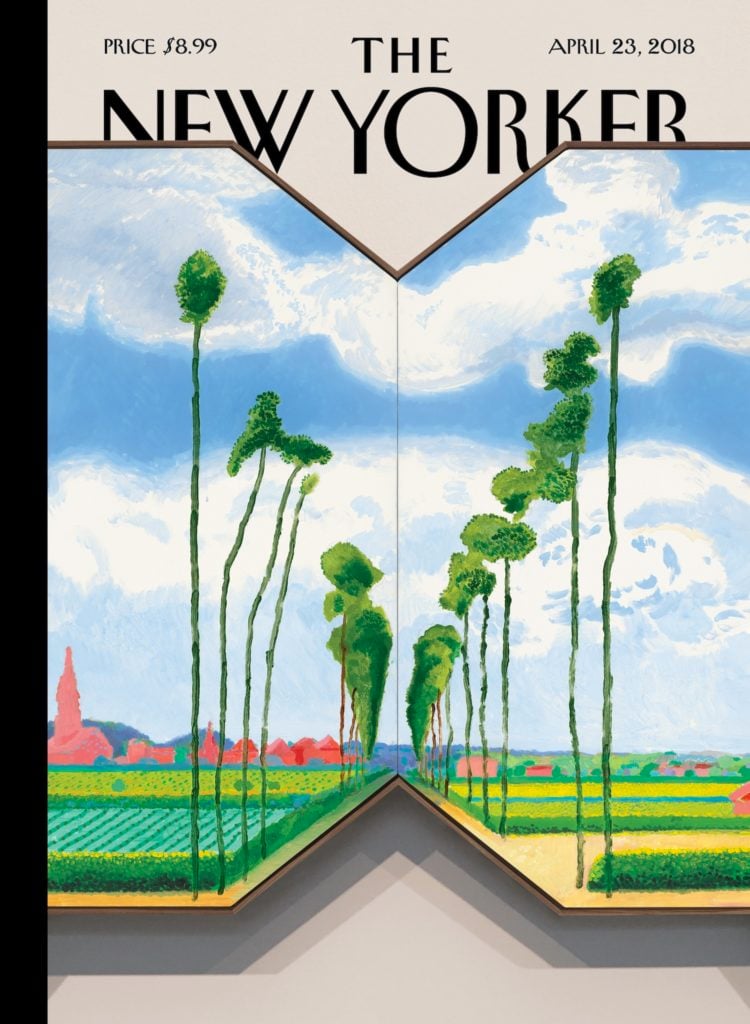Art World
How a 17th-Century Dutch Artist Inspired David Hockney’s Latest ‘New Yorker’ Cover
The 80-year-old British artist adapted a painting from his current show at Pace.

The 80-year-old British artist adapted a painting from his current show at Pace.

Sarah Cascone

Beloved British artist David Hockney has adapted one of his recent paintings for the cover of the latest issue of the New Yorker. A detail from his unconventionally shaped canvas Tall Dutch Trees After Hobbema (Useful Knowledge), 2017, the image shows a tree-lined road between green fields, stretching out into the distance beneath a blue sky.
The April 23 issue, titled “The Road,” is the magazine’s travel and food edition, making Hockney’s expansive, idyllic landscape a natural choice.
![Installation view, "David Hockney: Something New in Painting (and Photography) [and even Printing]" with <em>Tall Dutch Trees After Hobbema (Useful Knowledge)</em>, 2017, 510 West 25th Street, New York, April 5–May 12, 2018. Photo by Tom Barratt, ©2018 David Hockney.](https://news.artnet.com/app/news-upload/2018/04/Hockney_inst_2018_vD.jpg)
Installation view, “David Hockney: Something New in Painting (and Photography) [and even Printing]” with Tall Dutch Trees After Hobbema (Useful Knowledge), 2017, 510 West 25th Street, New York, April 5–May 12, 2018. Photo by Tom Barratt, ©2018 David Hockney.
“I’ve always loved it. It’s a beautiful painting, the original. It’s in the National Gallery, and I saw it when I was 18, when I first went to London,” the artist told the New Yorker. “What’s fascinating is that, in the painting, there are two vanishing points. One is in the center of the painting, with the disappearing road. But the other is in the sky. You’re always looking up, because the trees are so tall.”

Meindert Hobbema, The Avenue at Middelharnis (1689). Courtesy the National Gallery, London.
Hockney’s updated version is on view in New York through May 12 in “David Hockney: Something New in Painting (and Photography) [and even Printing]” at Pace. A multi-canvas work, the painting features the artist’s typical bright colors, but with an unusual canvas shape that matches features in the landscape.
It isn’t the first time Hockney’s been tapped to illustrate the New Yorker‘s cover—in fact, he did one in 2010, and two more the following year. They were all based on drawings he made on the iPad, a medium that dominated his practice for several years.
![David Hockney at the opening of "David Hockney: Something New in Painting (and Photography) [and even Printing]" at Pace Gallery in New York. Photo by Max Lakner/BFA, courtesy of Pace Gallery.](https://news.artnet.com/app/news-upload/2018/04/BFA_23713_28526413-943x1024.jpg)
David Hockney at the opening of “David Hockney: Something New in Painting (and Photography) [and even Printing]” at Pace Gallery in New York. Photo by Max Lakner/BFA, courtesy of Pace Gallery.